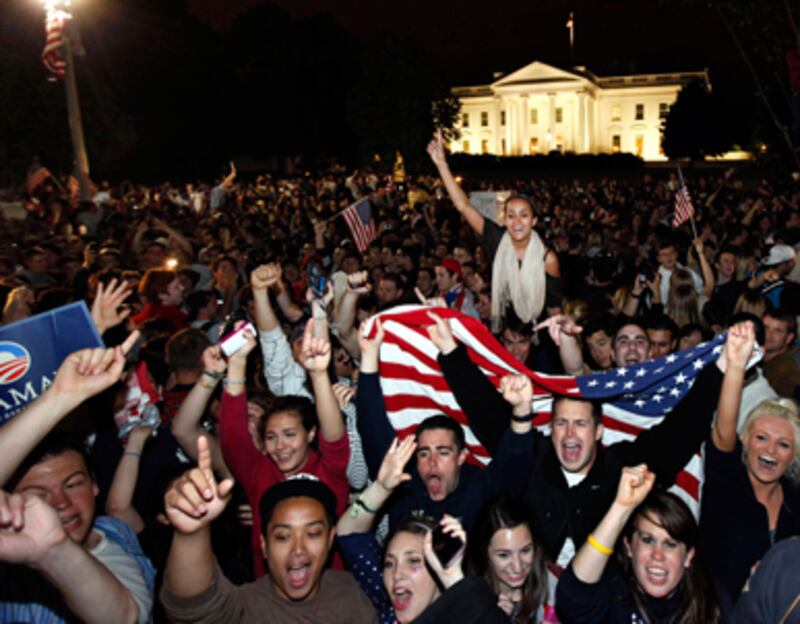Despite some skepticism greeting the news that Osama bin Laden was captured, killed, confidently identified with a DNA analysis, and dispatched into the sea—all within a matter of hours—geneticists are testifying to the technology that enables exactly this kind of speed.
Gallery: The World Reacts to bin Laden’s Death

Dr. Frederic Zenhausern, a biochemist and physicist, and the director of the Center of Applied Nano Biologoical Science and Medicine at the University of Arizona, has worked in DNA analysis for years. He’s developed a lightweight machine that streamlines the process of DNA analysis, but says that given the stakes of the mission in Pakistan, it’s likely that the most traditional and well-established methods of DNA analysis would have been used.
ADVERTISEMENT
• The Daily Beast's Complete Osama bin Laden CoverageThis process involves several steps, and serious equipment. The “lab bench” that could accommodate all the equipment necessary for accomplishing the analysis would be roughly 30 feet long; the combined weight of the equipment would be several hundred pounds. The first step for the U.S. officials on the scene would be to obtain a DNA sample—either a swab of the cheek or a sample of blood drawn from bin Laden’s body.
That sample would then be rushed to a laboratory set up for the task—at a nearby military base, a mobile laboratory, or even, conceivably, on the USS Carl Vinson, the same vessel in which bin Laden’s body was taken out to sea.
Once there, the sample taken from bin Laden would go through a purification process, with a technique known as PCR, with which specific sections of DNA are detected and amplified. Zenhausern says that it would be possible to get to this point of the analysis in roughly one hour; other protocols call for about two and a half hours to complete. The purified sample would then be stained with dye and loaded into a machine known as the “capillary electrophoresis,” a high voltage is applied, and 13 separate fragments—known as STRs-—emerge, identifiable because of the distinct way each one of these dyed fragments looks when reacting to the voltage applied.
The 13 fragments of STRs—short for Short Tandem Repeats—constitute the standard DNA profile. They are sections of DNA known, unflatteringly, as “junk DNA,” or as Dr. Barry Duceman, director of biological science for the New York state Police Forensic Investigation Center, more gently puts it, “DNA with no known function,” that does not translate into the various proteins manufactured by our more active genes.
No sophisticated data analysis would have been required because the DNA sample was taken directly from bin Laden’s body, and was therefore “clean.”
According to Duceman, junk DNA is used in DNA analysis for two reasons—one, each person has a unique pattern of STR fragments, making it his or her true DNA fingerprint. In fact, the chance that two unrelated people will share the same pattern of STRs is roughly one in 575 trillion. But there’s another reason for using junk DNA that’s less often discussed: It’s a way of protecting privacy.
STRs contain “no medically relevant information,” says Dr. Stanley Nelson, of UCLA’s Geffen School of Medicine. “They tend to be in places in the genome which do not have a known disease-related function.” CODUS—the national data bank of more than 10 million DNA samples—is composed entirely of individuals’ junk DNA.
Once the STRs have been pulled from their glass capillary, it’s down to a forensic expert to compare the profile—compiled in the form of a graph—to either a pre-existing sample of the same person’s DNA or to an individual’s family member. Matching two samples of DNA taken from the same person greatly simplifies the process of confirming identity.
To yield a DNA test of 99.9 percent accuracy—the number being put forward by the United States government—one former CIA agent told The Daily Beast, it was likely “we would have had his DNA on file for a long time,” either taken during the era when bin Laden worked with American forces against the Soviet occupation in Afghanistan, or in the years preceding 9/11, when he’d crept onto the intelligence radar as a terrorist threat.
There are also reports, however, that the sample taken from bin Laden’s body was compared with one from his half-sister, which the U.S. had obtained in recent years; Bin Laden had no full siblings, and half siblings share only 25 percent of their DNA, so such a sample would be less conclusive than a baseline DNA sample taken from bin Laden himself.
In terms of this week in Pakistan, Zenhausern adds that “no sophisticated data analysis” would have been required because the DNA sample was taken directly from bin Laden’s body, and was therefore “clean,” with “good sensitivity.”
“Here, the process is relatively simple,” says Nelson, referring to the capture and identification of bin Laden. “Does the sequence at these few positions match or does it not match?”
Duceman adds that in recent years, the process of analyzing DNA has been refined and significantly sped up—it could be done in a day, he says, albeit a very busy one.
Casey Schwartz is a graduate of Brown University and has a master's in psychodynamic neuroscience from University College London. She has previously written for The New York Sun and ABC News. Currently, she's working on a book about the brain world.






